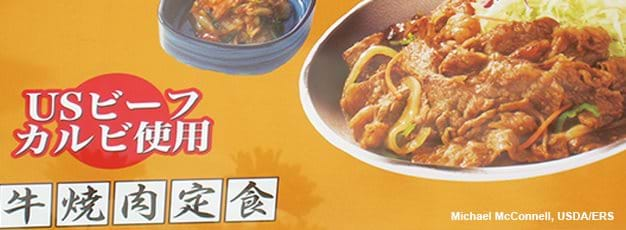Growing Beef Consumption in Japan Could Benefit U.S. Producers

Japan was once the largest export market for U.S. beef, importing as much as $1.6 billion worth of U.S. beef a year. This trade stopped in 2003 when Japan imposed trade bans and restrictions following the discovery of bovine spongiform encephalopathy (BSE) in the United States. U.S. beef regained access to the Japanese market in 2005, and exports have been growing since then. In 2009, Japan imported $470 million of U.S. beef, making it the second largest export market in value for U.S. beef.
The United States produces large amounts of specific meat cuts and offal that bring higher returns in Japan than in domestic markets. Japanese beef prices rose significantly following the 2003 trade restrictions, which severely limited supplies of these cuts. An increased presence of U.S. beef in Japan could bring higher returns for U.S. producers and lower prices for Japanese consumers. However, Japan continues to ban U.S. beef from cattle over 20 months old and requires mandatory age verification, limiting supplies that could reduce prices in Japan.
Rising consumption is the key to continued growth in the Japanese beef market. Prices, income, and demographics will determine the potential size of Japan's beef market. Japan's declining population means that total consumption would fall even if consumption per person remained constant. Only modest income gains are expected in Japan over the next decade, but price changes could influence future consumption. Japanese consumers appear to be sensitive to changes in price when making purchasing decisions for beef. ERS estimates that a decrease of 1 percent in beef prices will lead to increases in consumption greater than 1 percent.
ERS researchers analyzed multiple consumption scenarios for Japan using USDA's 10-year projections for income and population and estimates of Japanese consumers' response to changing economic conditions. In case 1, where prices and incomes do not change, consumption declines because the population declines. Case 2 shows that even modest income gains could help offset some of the effects of the population decline. Case 3 demonstrates much larger changes to consumption if prices decrease, here set at 2 percent per year.
The analysis shows that there is potential for the Japanese beef market to continue growing, particularly if prices decrease. Improved access to imported beef could trigger such decreases and lead to higher consumption. This would be good news for U.S. producers, as much of this increased demand would likely be captured by U.S. beef.
Japan's Beef Market, by Kakuyu Obara, Michael J. McConnell, and John Dyck, USDA, Economic Research Service, August 2010


